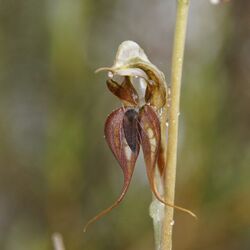Biology:Pterostylis lingua
| Large-lipped rustyhood | |
|---|---|

| |
| Pterostylis lingua growing near Werrimull | |
| Scientific classification | |
| Kingdom: | Plantae |
| Clade: | Tracheophytes |
| Clade: | Angiosperms |
| Clade: | Monocots |
| Order: | Asparagales |
| Family: | Orchidaceae |
| Subfamily: | Orchidoideae |
| Tribe: | Cranichideae |
| Genus: | Pterostylis |
| Species: | P. lingua
|
| Binomial name | |
| Pterostylis lingua M.A.Clem.[1]
| |
| Synonyms[1] | |
|
Oligochaetochilus linguus (M.A.Clem.) Szlach. | |
Pterostylis lingua, commonly known as the large-lipped rustyhood, is a plant in the orchid family Orchidaceae and is endemic to south-eastern Australia . It has a rosette of leaves and up to ten dark reddish-brown flowers with translucent "windows" and a blackish, insect-like labellum.
Description
Pterostylis lingua, is a terrestrial, perennial, deciduous, herb with an underground tuber. It has a rosette of between three and twelve elliptic leaves at the base of the flowering spike, each leaf 10–35 mm (0.4–1 in) long and 8–12 mm (0.3–0.5 in) wide. Up to ten dark reddish-brown flowers with translucent windows and 25–32 mm (0.98–1.3 in) long, 8–11 mm (0.3–0.4 in) wide are borne on a flowering spike 150–350 mm (6–10 in) tall. Four to seven stem leaves are wrapped around the flowering spike. The dorsal sepal and petals form a hood or "galea" over the column with the dorsal sepal having an upturned point 5–8 mm (0.2–0.3 in) long. The lateral sepals turn downwards, wider than the galea and suddenly taper to tips 10–12 mm (0.4–0.5 in) long which spread apart from each other. The labellum is blackish-brown, thin and insect-like, 6–7 mm (0.2–0.3 in) long and about 3 mm (0.1 in) wide. The thickened "head" end has many short hairs and the "body" has seven to ten longer hairs on each side. Flowering occurs from September to October.[2][3][4][5]
Taxonomy and naming
Pterostylis lingua was first formally described in 1989 by Mark Clements from a specimen collected in the Cocoparra National Park and the description was published in Australian Orchid Research.[1] The specific epithet (lingua) is a Latin word meaning "tongue".[6]
Distribution and habitat
The large-lipped rustyhood grows in drier forest and woodland and is locally common between Cootamundra and Bourke New South Wales.[4] In South Australia it only occurs in the Eastern Bioregion[7] and in Victoria, only in the far north-western corner of that state.[3]
Conservation
Only about 1500 plants of Pterostylis lingua are known in Victoria, where the species is classed as "endangered"[3] and it is also considered to be "endangered" in South Australia.[7]
References
- ↑ 1.0 1.1 1.2 "Pterostylis lingua". APNI. https://id.biodiversity.org.au/instance/apni/487674. Retrieved 18 May 2017.
- ↑ Jones, David L. (2006). A complete guide to native orchids of Australia including the island territories. Frenchs Forest, N.S.W.: New Holland. p. 330. ISBN 978-1877069123.
- ↑ 3.0 3.1 3.2 Jeanes, Jeff. "Pterostylis lingua". Royal Botanic Gardens Victoria: vicflora. https://vicflora.rbg.vic.gov.au/flora/taxon/3d1e8d37-9329-4928-b6b4-13bce5c8d41e. Retrieved 18 May 2017.
- ↑ 4.0 4.1 Jones, David L.. "Pterostylis lingua". Royal Botanic Garden Sydney: plantnet. http://plantnet.rbgsyd.nsw.gov.au/cgi-bin/NSWfl.pl?page=nswfl&lvl=sp&name=Pterostylis~lingua. Retrieved 18 May 2017.
- ↑ Reiter, Noushka; Clements, M. A.; Vlcek, Kate (2013). "An examination of Pterostylis xerophila (Orchidaceae) and the confirmation of P. lingua as a new species in Victoria". Muelleria: An Australian Journal of Botany 31: 69––76. doi:10.5962/p.295680. ISSN 0077-1813. https://www.rbg.vic.gov.au/media/y5fkkkip/muelleriavol-31-p69-reiter-pdf-accessibility.pdf.
- ↑ Brown, Roland Wilbur (1956). The Composition of Scientific Words. Washington, D.C.: Smithsonian Institution Press. p. 486.
- ↑ 7.0 7.1 "Census of South Australian Plants - Pterostylis". State Herbarium of South Australia; eflora SA. http://www.flora.sa.gov.au/cgi-bin/census_display.cgi?family=&genus=Pterostylis&species=&content=search&style=book&format=HTML&submit=Search&synonym=1. Retrieved 18 May 2017.
Wikidata ☰ Q15492058 entry
 |

